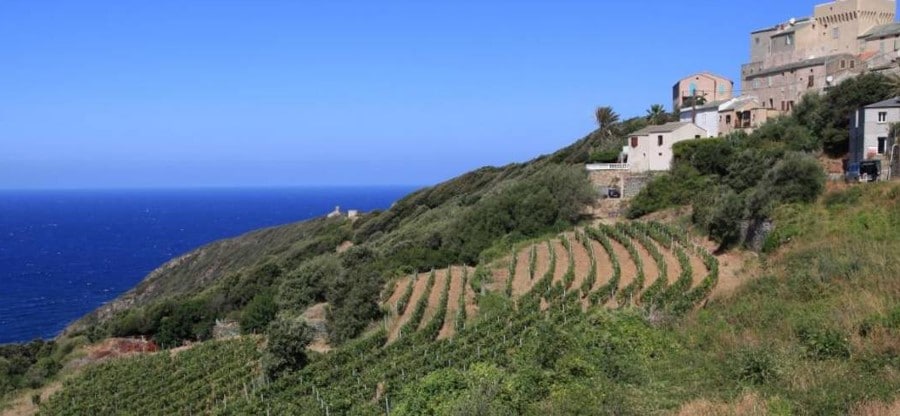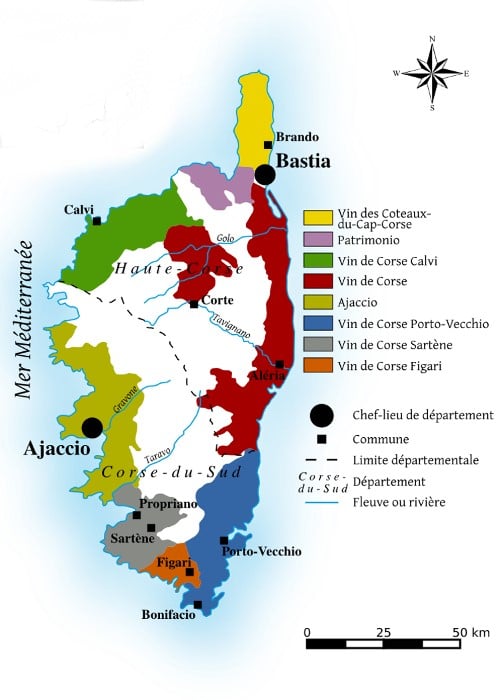
Vineyards and wines of Corsica : The vineyard Corsica stretches all around the coast of the Corsica, on granite soils (south and west), on schists (east and north), or on limestone soils. It is a Mediterranean land bathed in sun and heat often tempered by the sea always very close.
History of the Corsican vineyard
Antiquity: Viticulture began in Corsica in the XNUMXth century BC with the arrival of the Greeks, then it was developed more intensively by the Romans.
Middle Ages: It was the religious orders that gave a boost to viticulture throughout the Middle Ages.
Renaissance: In the XNUMXth century, the cartographer Ignazio Danti, who painted Corsica on the ceiling of the Vatican gallery, wrote: “Corsica has received four major gifts from nature: its horses, its dogs, its proud and courageous men and its wines, generosissimi, that the princes hold in the highest esteem! ".
Modern period: In the 1788th century and 1896th century, Corsican viticulture experienced spectacular development. Between XNUMX and XNUMX its production more than doubled, and the island could easily export to the Paris region thanks to the arrival of the railway in Sète. At the end of the XNUMXth century, the damage caused by the phylloxera are an economic disaster and production collapses.
Contemporary period: At the beginning of the 1960s, with the installation in Corsica of 17 returnees from Algeria, Corsican viticulture will be relaunched, but in an almost industrial manner, with the planting of high yielding grape varieties over nearly 000 hectares. . Little by little, Corsican wines take the place occupied by Algerian table wines in a range of table wines at low prices and of more than modest quality.
However, this policy goes against new consumption habits when sales of table wines collapsed from the 1970s. In twenty years, Corsican viticulture has lost two thirds of its vineyards, the total area of which has fallen from 32 hectares to just 000 hectares at the end of the 10s, ruining the local economy.
But, from the beginning of the 1990s, wine growers began to react and advocate quality. Today the Union of Corsican Wines and the Inter-Union Committee of Corsican Wines want to play the export card and seduce foreign markets with wines which will know how to seduce thanks to their structure.
Location
Orography: The island is a chain of mountains rising from the sea which culminates at more than 2 meters of altitude. Each of its valleys, which plunge into the sea, benefits from a different exposure and microclimate. The effects of these different exposures are combined with the process arising from the nature of the soils.
Geology: Corsica offers a wide variety of soils with schists to the east, granite soils to the west, as well as sedimentary alluvium in the center and limestone outcrops to the north and south.
Climatology: The whole island has an average rate of sunshine per year of around 2 hours. The summer heat is however moderated by maritime and mountain influences. In addition, the winter period is mild and short since frosts are rare, and early spring
Presentation of the Corsican vineyard:
The total production area is 5 ha of which 700 ha are in AOC. The Corsican vineyard is divided into nine appellations and 5 village denominations.
Grape varieties from the Corsican vineyard:
The vines traditional are:
- Debiti paga, white grape variety, undoubtedly the oldest in Corsica.
- malvasia coarse-grained
- nielluccio, a red variety resembling the Sangiovese from Tuscany and the main variety of the Patrimonio appellation in the north of the island. It covers 35% of all of the island's vineyards. On great terroirs like that of Patrimonio it gives remarkable wines but on others it quickly tends to lack personality.
- sciacarello is a grape variety found mainly in the south of the island and covers 15% of the vineyards. It gives very fine and peppery wines with a beautiful structure, but it is too often lean.
- Vermentino is a white wine variety. It is in fact a variety of Malvasia which produces very aromatic.
- wolverine black, black grape
- white wolverine, white grape
- kind biancu, white grape
- random, cap corse et patrimonio, for the elaboration of the rappu (mutated sweet wine withbrandy).
Types of wines corsets
Regional appellation: Corsican wine is produced on 1 hectares, ie 603% of approved areas.
Local appellations:
Ajaccio is produced on 260 ha or 8,5%.
The patrimonio produced on 413 ha or 13,5%.
Geographical names within the Corsica appellation:
Calvi produced on 227 ha or 7,4%.
Coteaux-du-Cap-Corse produces over 30 ha, i.e. 0,98%.
The figari produced on 130 ha or 4,3%.
Porto-vecchio is produced on 88 ha, i.e. 2,9%.
The sartene produced on 226 ha, ie 7,4%.
Natural sweet wine : Muscat du Cap-Corse produced on 74 ha, i.e. 2,4% 8.
Vins de pays: The vin de pays from Île-de-beauté (PGI) represents the first volume sold. Its share rose from 2 to 3% before 1980 to 60%. In 2011, their approval covered 237 hl. To fight against overproduction, linked to winemaking of large-producing grape varieties, a grubbing-up plan of more than 20 ha was followed by a program ofgrape variety traditional to the island. Which has cleaned up the market. Production is split between 28,5% red wines, 57,2% rosé wines and 14,2% white wines.
Farm structure: In 2015, there were 450 producers in Corsica, including six cooperative cellarsTwo IF IT and 110 private cellars.
Marketing of wine Corsica :
Corsican wine production: In 2011, wine production was 370 hl., Including:
112 hl in appellation of origin,
237 hl in local wines and varietal wines
20 hl in table wines
For Corsican wines AOC :
11,3% were white wines,
55,8% of rosé wines,
31,3% of red wines,
1,7% of muscats.
Official website of Corsican wines

